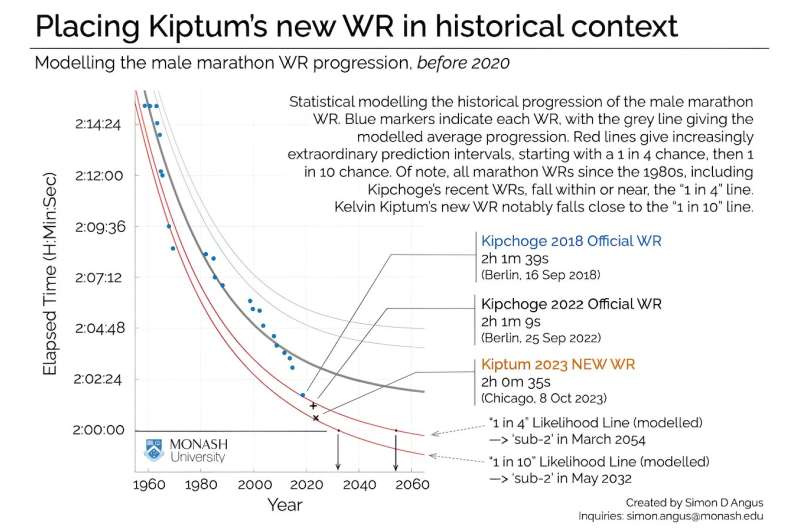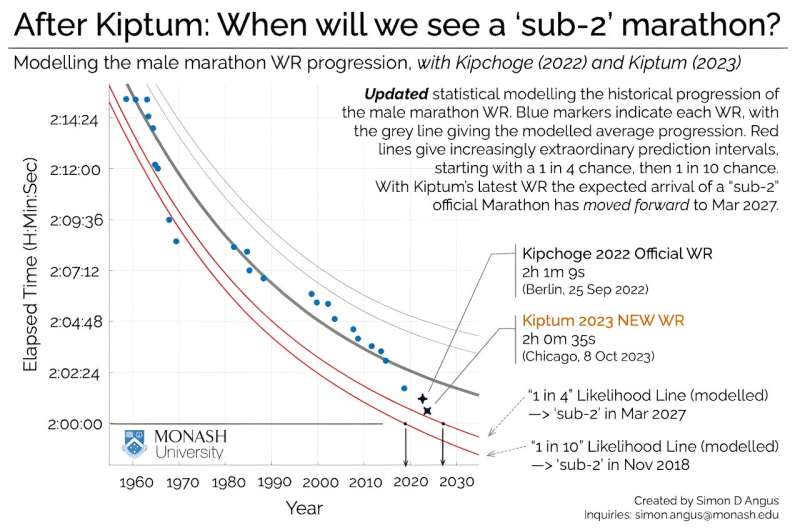This article has been reviewed according to Science X's editorial process and policies. Editors have highlighted the following attributes while ensuring the content's credibility:
fact-checked
trusted source
written by researcher(s)
proofread
Marathon under two hours closer than ever: Scientist shows how Kenya's Kiptum tests human limits

War in the Middle East plunged humanity to new lows on Sunday 8 October 2023 that have gripped international attention since. If that were not the case, the world would likely be abuzz with the breathtaking exploits of a 23-year-old Kenyan who changed running history in Chicago on the same day.
Kelvin Kiptum, running just his third marathon, finished the 42.195 kilometer race in 2h 00m 35s. This lowered the previous world record set by countryman Eliud Kipchoge in Berlin last year, by a whopping 34 seconds. This is the first time that the world record has been obliterated by more than 30 seconds since official ratification began 20 years ago. The better-known Kipchoge comes closest for clipping 30 seconds off his own mark in 2022.
Kiptum's jaw-dropping average pace was 21 kilometers per hour (13.04 mph) or just 2 minutes and 51.5 seconds per kilometer (4:36.0 min/mile).
My interest as a data scientist and economist (and fellow runner) lies in analyzing the historical progression of the men's and women's world marathon records.
Can the extraordinary feats of human endeavor be submitted to statistical analysis?
My approach is to think of the marathon world record progression as a bit like watching developments in technology. In both, many factors can lead to a performance gain. In the case of marathon running, this can include training regime, nutrition, psychological preparedness and equipment.
On 8 October, Kiptum didn't only set a new mark. He also changed the trajectory of the marathon world record.
By my calculations and analysis he has, in all likelihood, set the scene for the "sub-2 hour" marathon mark to fall in the next few years. Prior to Kiptum's run, I was less convinced we would see the milestone fall before the end of the decade.
Why are we still talking about 'sub-2'?
Didn't Kipchoge already go "sub-2" back in 2019? Well, not really.
Athletics is one of those sports where official record keeping really counts. Courses have to be measured (three times) to within a centimeter, lines must be crisp and clear, hurdles must be set out in rows with military precision and athletes must crouch frozen in place without as much as a hair moving until the starter's gun rings out. There's a whole rulebook set down by the International Association of Athletics Federation for a road marathon to be called "official."
And so, when Kipchoge (backed by a million-dollar funded team) ran as the only "competitor" for 1h 59m and 40s around the Prater Hauptallee in Vienna in October 2019, everyone, including Kipchoge, knew this was not the end of the grand search for an official sub-2.
The world record remained at Kipchoge's own 2h 1m 39s set in the Berlin marathon in September 2018. Kipchoge would go on to lower his own official marathon world record to 2h 1m 9s in September last year, also in the Berlin marathon.
And that is where the official record stayed, until October 8.
How good was Kiptum's new world record?
There are many ways we could answer this question. For amateurs and elites alike, there are so many ways that one could seek to improve their performance. These include (though the list is much longer):
- training choices (volume, intensity, rest, cross-training)
- nutrition (micro- and macro-nutrients, pre-race fuelling, in-race hydration)
- psychological training (set-backs, performance anxiety, boredom, motivation, self-talk)
- equipment tech in shoes and apparel.
From the standpoint of statistical and economic analysis, after making a few assumptions, we can expect that the arrival of a world record in the marathon might follow a defined pattern. So much so, we can model the historical times, which is to say, fit a mathematical formula to them, and so, gain insights about the present and the future.
Economists have been modeling athletic performance for decades. We now know that so long as the arrival rate of small improvements (think: a new supplement, shoe foam, or training aid) across each factor is roughly consistent over time, we should expect that the summary outcome will have reasonably predictable behavior. It's this overall process we can model.

My approach is to fit a model to the average trend of marathon world record times over several decades, and then to estimate the likelihood of going below this trend to run a given time on a given day.
First up, we can model the historical progression of the male world record as if we didn't know about Kipchoge's 2022 world record and Kiptum's new mark. This will tell us how unusual (or unexpected) these times were, from the perspective of history.
What we find is that, whereas Kipchoge's run on that particular September 2022 day ("+" in figure below) was remarkable, with a likelihood of close to "1 in 4" chance, based on history, Kiptum's run was, statistically speaking, more impressive. Kiptum's run ("x" in the figure below) lands closer to the "1 in 10" likelihood line.
In other words, Kiptum's performance is less expected (or more unusual), based on the historical world record progression line, than Kipchoge's. This is so even if you take into account the natural progression of the world record we'd expect over the year between the runs.
Given how amazing Kipchoge's Berlin 2022 run was, that's saying something.
Does Kiptum change sub-2 expectations?
Let's suppose that a hypothetical runner in the mold of Kiptum was at the start line in future (official) marathons. When would they go sub-2?
By following the "1 in 10" line out into the future, we see that it crosses the 2 hour line in May 2032. This is no different to what I predicted four years ago.
However, what if we allow our modeling procedure to take account of both Kipchoge's and Kiptum's new 2022 and 2023 world records respectively?
When I add only Kipchoge's mark, and work with a runner like Kipchoge at "1 in 4" likelihood, the sub-2 moment doesn't change very much, moving forward by just a few months to November 2031.
However, if we further add Kiptum's more extraordinary run, something remarkable happens.
First, the model learns to be a bit more accommodating of Kiptum-like performances. In effect, he becomes a bit less extraordinary, tracking closer to the updated "1 in 4" likelihood line.
Second, if we follow this line—that is, we assume that a Kiptum-like runner is at the start line in future official marathons—then we find that the arrival of a sub-2 marathon has been brought forward by five years to March 2027.
In effect, Kiptum (and to some extent Kipchoge in 2022) have been able to nudge all of marathon world-record history just enough to make the sub-2 moment a likely reality in the next few years.
Will we see more records beyond sub-2?
These curves tell us something else. If we run them out to the far distant future, they eventually settle on the very fastest time anyone might ever run in the marathon. The "limits," if you will, of human performance.
If we follow the "Kiptum line" ("1 in 4" likelihood) we find that it settles at 1h 55m 40s. Around 2 minutes faster than my prediction for the same four years ago. Again, Kiptum has made his mark.
If there's anything reassuring about this analysis, especially for those who love the marathon and this period of amazing running by men and women alike, even when (not if) the sub-2 mark is done, the limit is still over 4 minutes ahead!
In high performance terms, even after someone goes sub-2, there's still a lot to play for.
This article is republished from The Conversation under a Creative Commons license. Read the original article.![]()


















